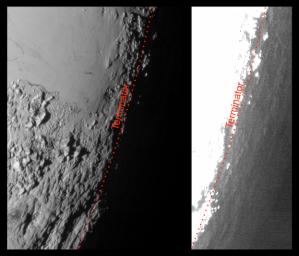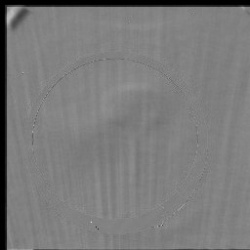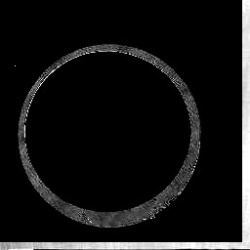wow lens flare and reflections
see phil's post
http://www.unmannedspaceflight.com/index.p...st&p=227718
Full Version: Pluto Surface Observations 2: NH Post-Encounter Phase
It's part of bigger mosaic (720 images in total) and I think that main reason for this deep mosaic was searching for rings.
In the first 90 images there aren't rings, only stars (at least in compressed jpegs).
In the first 90 images there aren't rings, only stars (at least in compressed jpegs).
Very nice Daniel. What did you use to co-register the frames, if I might ask?
ImageJ + Template Matching plugin.
Ahh, ImageJ!  Is there ANYTHING it can't do?!
Is there ANYTHING it can't do?!
If I may ask a bit off topic, what is the New Horizons image release policy? Are there any embargoes like the ESA's Rosseta mission? Does NASA have any embargos at all? I see conflicting information on the web.
NH, and NASA in general, has a good image use policy, which is typically listed at the bottom of the Image/Gallery Page. They do not bogart their pics as some do. 
--Bill
--Bill
I wrote an article right after the flyby explaining the New Horizons image release policy and how it compares to other NASA and ESA mission release policies. TL;DR: Policies differ from mission to mission. New Horizons releases a few captioned images on Thursdays and all raw images downlinked (as of end of business Tuesday) on Fridays.
A lot of images have been released of Pluto's night side on the LORRI page. Charonshine imaging?
http://pluto.jhuapl.edu/soc/Pluto-Encounte...Date&page=1
http://pluto.jhuapl.edu/soc/Pluto-Encounte...Date&page=1
At the time those images were taken (July 15, ~1:50 UTC), half of Pluto's night side was visible from Charon; the other half was not. So if there is something to see there, we should see that one side of the dark disc is lit with a gradation towards total darkness on the other half.
As the attached text notes, the Sun is not too far from the direction of the camera. That is a problematic factor: If NH had a view of Pluto's entire dark side, and Charon were illuminating the entire dark side, then the Sun would be right in the line of sight. When you add in that Pluto's atmosphere is scattering light, the signal:noise for Charonshine images may be unfavorable. The atmosphere was not a problem with, e.g., Saturn and Iapetus.
As the attached text notes, the Sun is not too far from the direction of the camera. That is a problematic factor: If NH had a view of Pluto's entire dark side, and Charon were illuminating the entire dark side, then the Sun would be right in the line of sight. When you add in that Pluto's atmosphere is scattering light, the signal:noise for Charonshine images may be unfavorable. The atmosphere was not a problem with, e.g., Saturn and Iapetus.
You can really see there how extremely tall Pluto's atmosphere is. I went to look on NASA's Pluto factsheet and the scale height is 60 km apparently.
Could there be detail lurking in the uncompressed versions of these back-lit images? After all, night-side terrain is distinctly visible in the LORRI image here: http://photojournal.jpl.nasa.gov/catalog/PIA19931 , even though the released 'raws' show little or no hint of it.
We may have differing situations here. It's good we can see terrain from twilight illumination at a low phase angle. It would be more difficult to see this scene from a high phase angle, considering either twilight illumination or Charonshine.
Farther onto the night side it still might be possible to see some terrain via Charonshine, though the highest amount of Charonshine was still close to the limb IIRC.
Farther onto the night side it still might be possible to see some terrain via Charonshine, though the highest amount of Charonshine was still close to the limb IIRC.
Scattered light and illumination from Plutos's sky (atmosphere) is probably also a significant factor on Pluto's nightside near the terminator (there's a twilight area there).
After taking a quick look at these new JPGs I don't think the individual images show any details on Pluto's nightside but stacking might reveal some details. In contrast, individual, original 16 bit images might very well contain subtle details.
After taking a quick look at these new JPGs I don't think the individual images show any details on Pluto's nightside but stacking might reveal some details. In contrast, individual, original 16 bit images might very well contain subtle details.
Here's a TXT file of the Pluto Charon-shine frames, suitable for using with WGET:
Click to view attachment
Click to view attachment
Some blooming?
Click to view attachment
If so, there's something pretty bright in there... It's in all the frames.
Click to view attachment
If so, there's something pretty bright in there... It's in all the frames.
Some very very faint traces of the night side of Pluto when registering and adding all the last Pluto's images illuminated by Charon. This is fairly difficult to notice anything but as about 180 images have been processed, the S/N ratio is quite good, so these traces should not be artifacts.
Click to view attachment
Fred
Click to view attachment
Fred
Why haven't we gotten any new captioned images on Thursday  ?
?
Here is a better version of the night face of Pluto :
Click to view attachmentClick to view attachment
Fred
Click to view attachmentClick to view attachment
Fred
Definitely getting some features here Fred. Good work!
Edit: Looking at the positions within the system, I actually think this may be mostly scattered light rather than Charon-shine.
I tried enhancing the contrast a little more here as well.
Click to view attachment
Edit: Looking at the positions within the system, I actually think this may be mostly scattered light rather than Charon-shine.
I tried enhancing the contrast a little more here as well.
Click to view attachment
Here is a better version of the night face of Pluto
Thanks a lot, Fred. Could you explain what you did? In addition to registering on the crescent of Pluto, did you attempt to remove the obvious scattered light that's mainly around the centre of each frame? As you go through the 180-odd frames, the crescent shifts around but the scattered light stays pretty much at a fixed position in the frames. But the positions scanned by the crescent aren't very uniform, so if you just average all the frames after registering you'd expect to see brighter and darker patches on the dark side due to the averaging of the scattered light. In particular, the lower-right part of the dark side never really gets into the scattered light, so that might explain why the lower-right part of the dark side is dark on your image.
What I'd do (if I had the time) would be to first produce a template for the scattered light (maybe by averaging some frames with the crescent removed), and then subtract that template (suitably normalized) from each frame, before registering on the crescent and doing the final average. "Suitably normalized" is the hard part here - but I wouldn't be surprized if there's an imageJ plugin to do that...
Edit: Looking at the positions within the system, I actually think this may be mostly scattered light rather than Charon-shine.
Yes I do agree with you. Charon is very dark compared to Pluto atmosphere's scattered light and the area where the details are visible is located on the limb near the Sun's direction : bottom right side. Charon's illuminated area is on the bottom left side of Pluto and we see nothing there.
I haven't tried yet but I think you could probably stack enough of the frames together to cancel out the crescent as noise and then you could use that as your dark frame. Might have a go at this today.
Edit: Well, it worked actually really well at taking out scattered optical rays but being 8bit jpgs, it made everything too smooth.
Click to view attachment
This was a stack of the 22 images on the 1st page. Maybe it would work better with more frames. Or maybe some preprocessing on the frames would benefit or mixing in preprocessed with unprocessed. Lots of options here still.
With the raw images, you could probably just readjust the stretching on the image and start seeing some features.

Edit 2: Also, here's the stacked frame I used for a dark frame, if anyone else wants to try.
Click to view attachment
Edit: Well, it worked actually really well at taking out scattered optical rays but being 8bit jpgs, it made everything too smooth.
Click to view attachment
This was a stack of the 22 images on the 1st page. Maybe it would work better with more frames. Or maybe some preprocessing on the frames would benefit or mixing in preprocessed with unprocessed. Lots of options here still.
With the raw images, you could probably just readjust the stretching on the image and start seeing some features.
Edit 2: Also, here's the stacked frame I used for a dark frame, if anyone else wants to try.
Click to view attachment
What I did :
1) download all images
2) convert them to FITS with Iris ( http://www.astrosurf.com/buil/us/iris/iris.htm )
3) make a master flat from all the images (I used a master bias made from a batch of 11 photos of short duration from "black" pictures of Nix, Hydra...)
4) process the FITS (remove offset, divide by flat)
5) align the resulting images (planetary registration)
6) stack the images (sigma median)
Then I saved the result in PSD format.
In Photoshop (CS2) :
1) resample the image by 400%
2) remove the borders with are crapy
3) play with the curves to get max details
4) enhance details with a local enhancement filter (see principle : http://www.cambridgeincolour.com/tutorials...nhancement.htm)
5) adjust curves again
Save and stop !
Fred
1) download all images
2) convert them to FITS with Iris ( http://www.astrosurf.com/buil/us/iris/iris.htm )
3) make a master flat from all the images (I used a master bias made from a batch of 11 photos of short duration from "black" pictures of Nix, Hydra...)
4) process the FITS (remove offset, divide by flat)
5) align the resulting images (planetary registration)
6) stack the images (sigma median)
Then I saved the result in PSD format.
In Photoshop (CS2) :
1) resample the image by 400%
2) remove the borders with are crapy
3) play with the curves to get max details
4) enhance details with a local enhancement filter (see principle : http://www.cambridgeincolour.com/tutorials...nhancement.htm)
5) adjust curves again
Save and stop !
Fred
Why haven't we gotten any new captioned images on Thursday  ?
?
The New Horizons team is preparing for a big week at the AAS/DPS meeting with dozens of research report talks and posters, as well as a press briefing. Many new results will be announced. As a result there will be no Thursday captioned releases the weeks of Nov 2 and 9. There will however be a NASA news release summarizing major DPS highlights.
I'm worried the Charon shine imaging didn't work.
there will be no Thursday captioned releases the weeks of Nov 2 and 9. There will however be a NASA news release summarizing major DPS highlights.
And there was the very welcome announcement of the successful trajectory adjustment toward the next target which for me was more than compensation for the absence of an image release that day.
https://www.google.co.uk/url?sa=t&rct=j...0p9l1jCYDAHbHpw
I'm worried the Charon shine imaging didn't work.
It was always a bit of a shot in the dark. For completeness it had to be tried.
I'm worried the Charon shine imaging didn't work.
I definitely wouldn't jump to that conclusion so fast.
Take this image for instance:

(click to enlarge)
Both the right and left images are from the exact same source but if you were to crop around the darker image on the left, there is no way you will be able to extract enough data to reach the version on the right. The raw files contain 16-times more data than this version or any of the files on SOC. Looking at the above linked image, I can almost guarantee we will have more to add to the Pluto map.
The Charonshine images may work better if the black sky images are used in combination with the Pluto images. To properly use them would probably requires the pointing information for both the blank sky images and the Pluto images which the New Horizons team has but the image gurus don't. Maybe we will see some better results at the DPS conference.
3) make a master flat from all the images (I used a master bias made from a batch of 11 photos of short duration from "black" pictures of Nix, Hydra...)
Thanks a lot for the details, Fred. But what you've done to make the flat is still unclear to me - if you'd be willing to post the flat, well, that would be worth 1000 words...
The New Horizons team is preparing for a big week at the AAS/DPS meeting with dozens of research report talks and posters...
Great news, that is what I will be looking forward to. Worth more than interminable discussions about the airspeed velocity of swallows in a Plutonian atmosphere...
8-13 November 2015
http://aas.org/meetings/dps47
--Bill
Any chance it might be one of the inner planets (by which I mean anything interior of Pluto)?
I checked - Pluto was well outside the plane of the ecliptic at the time of these images and all of the planets are way outside the field of view. So maybe that blip alongside the crescent is a star. Or blooming from the crescent.
I've looked at the blip on the limb in several of the images independently and stacked sets. Part of me wants to hope it is something rising off the surface, or possibly some high altitude crystals deeper in the atmosphere causing the bloom. Realistically, its probably just a slightly more dense portion of the atmosphere there and its just standard CCD bloom. Definitely be worth noting and looking at in the raws if there isn't some announcement about finding something prior to that.
I checked - Pluto was well outside the plane of the ecliptic at the time of these images and all of the planets are way outside the field of view. So maybe that blip alongside the crescent is a star. Or blooming from the crescent.
Which image or images are you referring to? I see something around 5:00 iin ZLD's post#125 image.
Thats the point in question. Its in every raw image off SOC that I've seen (I've only looked at around 30 of them).
Also, here's the stacked frame I used for a dark frame, if anyone else wants to try.
I guess the problem is that the crescent is so much brighter than the scattered light that it doesn't average away. So you'd expect to see that residual smeared crescent in your dark frame subtracted images. Except for inside the smallish region where the crescent smear doesn't cover.
Maybe the way to do this would be to mask the crescent out of each frame before averaging to create the dark frame, taking account the masking when taking the average. Not an easy job...
I was planning to follow the Pluto session of the DPS conference on twitter (Emiliy's list) but some @#%*! declared an embargo.
I was planning to follow the Pluto session of the DPS conference on twitter (Emiliy's list) but some @#%*! declared an embargo.
What's the justification for that? And what authority do they have to enforce it? the #dps15 tag on twitter is a MESS right now lol
Icy volcanoes may dot Pluto's surface New Horizons mission spots a pair of mountains with deep pits at their centres.
Must be those stratovolcanos mentioned in one of the abstracts.
ETA: Some images: http://pluto.jhuapl.edu/Multimedia/Science...hp?gallery_id=2
Must be those stratovolcanos mentioned in one of the abstracts.
ETA: Some images: http://pluto.jhuapl.edu/Multimedia/Science...hp?gallery_id=2
Slides from press conference: http://pluto.jhuapl.edu/News-Center/Press-...mber-9-2015.php
Look at that dark-side detail!:
Click to view attachment
And in 3D, no less. I wonder what else lurks in the overall imagery.
Click to view attachment
And in 3D, no less. I wonder what else lurks in the overall imagery.
Wow, so Piccard Mons was seen only via Plutonian twilight back-scatter? 
To my eyes, Wright Mons looks more like an uplift with subsequent central collapse and surface deformation than a volcanic construct. But still, such a process could still be due to and result in the movement and eruption of icy magma.
I need to do an update to this with the better available data but here is the morph I did of Wright Mons once again.

(GIF link)
Also, with how clear the backscatter came out, I can't express how excited I am to see more twilight images. We are probably in for some great twilight images because during the crescent image, LORRI was snapping images as well.

(GIF link)
Also, with how clear the backscatter came out, I can't express how excited I am to see more twilight images. We are probably in for some great twilight images because during the crescent image, LORRI was snapping images as well.
This is a "lo-fi" version of our main content. To view the full version with more information, formatting and images, please click here.


